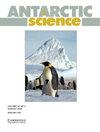First de novo transcriptome analysis of the Antarctic springtail Cryptopygus terranovus (Collembola: Isotomidae) following mid-term heat exposure
IF 2
4区 地球科学
Q3 ENVIRONMENTAL SCIENCES
引用次数: 2
Abstract
Abstract Global human activities, such as greenhouse emissions and pollution, are promoting global warming, environmental changes and biodiversity reduction. Pristine environments such as those of Antarctica are not immune to these phenomena, as is noticeable from the increasing pace of the temperature shift registered within the continent in recent decades. In this study, we describe the first de novo transcriptome analysis of the endemic Antarctic springtail (= collembolan) Cryptopygus terranovus and we evaluate its global gene expression response following a mid-term exposure of 20 days to 18°C. Expression data are compared with wild specimens sampled from their native environment to outline the molecular mechanisms triggered by the thermal exposure. Although individual plasticity in transcript modulation is assessed, several pathways appear to be differentially modulated in springtails subjected to the heat treatment vs wild specimens. Through enrichment analysis, we show that protein catabolism, fatty acid metabolism and a sexual response characterized by spermatid development are induced, while carbohydrate consumption, lipid catabolism and tissue development are downregulated in treated samples compared to controls.中期高温暴露后南极跳尾隐锥虫的首次从头转录组分析
摘要全球人类活动,如温室气体排放和污染,正在促进全球变暖、环境变化和生物多样性减少。南极洲等原始环境也不能免受这些现象的影响,近几十年来,该大陆的温度变化速度越来越快,这一点显而易见。在这项研究中,我们描述了对南极特有的弹尾虫(collembolan)隐锥虫的首次从头转录组分析,并评估了其在中期暴露于18°C 20天后的全球基因表达反应。将表达数据与从其原生环境中取样的野生标本进行比较,以概述热暴露引发的分子机制。尽管对转录物调节的个体可塑性进行了评估,但与野生标本相比,经过热处理的弹尾虫似乎有几种途径受到了不同的调节。通过富集分析,我们发现与对照组相比,处理样品中的蛋白质分解代谢、脂肪酸代谢和以精子发育为特征的性反应被诱导,而碳水化合物消耗、脂质分解代谢和组织发育被下调。
本文章由计算机程序翻译,如有差异,请以英文原文为准。
求助全文
约1分钟内获得全文
求助全文
来源期刊

Antarctic Science
地学-地球科学综合
CiteScore
3.60
自引率
6.20%
发文量
42
审稿时长
3 months
期刊介绍:
Antarctic Science provides a truly international forum for the broad spread of studies that increasingly characterise scientific research in the Antarctic. Whilst emphasising interdisciplinary work, the journal publishes papers from environmental management to biodiversity, from volcanoes to icebergs, and from oceanography to the upper atmosphere. No other journal covers such a wide range of Antarctic scientific studies. The journal attracts papers from all countries currently undertaking Antarctic research. It publishes both review and data papers with no limits on length, two-page short notes on technical developments and recent discoveries, and book reviews. These, together with an editorial discussing broader aspects of science, provide a rich and varied mixture of items to interest researchers in all areas of science. There are no page charges, or charges for colour, to authors publishing in the Journal. One issue each year is normally devoted to a specific theme or papers from a major meeting.
 求助内容:
求助内容: 应助结果提醒方式:
应助结果提醒方式:


